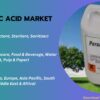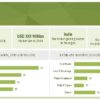Peracetic Acid Market 2025 Growth, Size, Trends, and Shares by Top Players
The report “Peracetic Acid Market by Grade (<5% Grade, 5–15% Grade, >15% Grade), Application (Disinfectant, Sterilant, Sanitizer), End-use Industry [Healthcare, Food & Beverage, Water Treatment, Pulp & Paper, Other End-use Industries (Agriculture, Wineries, Breweries, Laundry)], and Region – Global Forecast to 2030“, Global peracetic acid market size is projected...
Peracetic Acid Market Latest Industry Trends: Revenue, Price, Sales Analysis Report 2025-2030
The peracetic acid market is projected to grow from USD 1.11 billion in 2025 to USD 1.67 billion by 2030, at a CAGR of 8.5%, in terms of value. Peracetic acid is a liquid mixture of hydrogen peroxide and acetic acid, play a pivotal role in various industries, including healthcare, food & beverages, water treatment, pulp & paper and others. These versatile chemicals have gained significant...
Peracetic Acid Market Growth, Global Size, Opportunities, Key Producers, Share, Trends, Segmentations, Regional Graph Analysis and Forecast

The global peracetic acid market size is projected to grow from USD 1.0 billion in 2023 to USD 1.4 billion in 2028, at a CAGR of 7.4%. Peracetic acid is a liquid mixture of hydrogen peroxide and acetic acid, play a pivotal role in various industries, including healthcare, food & beverages, water treatment, pulp & paper and others. These versatile chemicals have gained significant importance...
Global Peracetic Acid Market Surges to $1.4 Billion by 2028: Rising Demand in Water Treatment and Food Processing Industries Drives Growth

The global peracetic acid market size is projected to grow from USD 1.0 billion in 2023 to USD 1.4 billion in 2028, at a CAGR of 7.4%. Acetic acid and hydrogen peroxide are combined to form peracetic acid, which is a watery solution. It is a clear, colorless liquid with a sharp odor and a low pH level. There are numerous commercial formulations available. Peracetic acid dissolves in solution...
Navigating the Growth and Applications of the Peracetic Acid Market

The peracetic acid market is projected to grow from USD 664.9 million in 2018 to reach USD 989.2 million by 2023, at a CAGR of 8.27%, during the forecast period. The peracetic acid market has been segmented on the basis of application, end-use industry, and region. The consumption trend of peracetic acid depends on the growth of various end-use industries. The demand for peracetic acid is increasing...
Peracetic Acid Market Poised to Account for US$ 1,685 Million by 2030

The peracetic acid market size is estimated to be USD 813 million in 2020 and is projected to reach USD 1,685 million by 2030, at a CAGR of 7.6%, between 2020 and 2030. Peracetic acid is widely used as disinfectant, sanitizer, bleach, sterilant, industrial reagent, oxidizer, and polymerization catalyst. It is a strong oxidizing agent and has stronger oxidation potential than chlorine or chlorine dioxide....